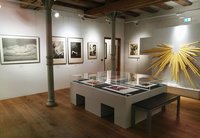Blatt 4 der lithografischen Folge "Szenen aus dem Leben Christi" von James Ensor (1860-1949).
Eine Frau sitzt mit einem lebhaft strampelnden Kind quer auf einem Esel. Der Esel wird von einem elegant-geschwungenem Lichtwesen am linken Bildrand geführt. Ein Mann mit Hörnern auf dem Kopf fängt den Dung des Esels auf.
Signiert in der Platte links unten mit "Ensor".
en









